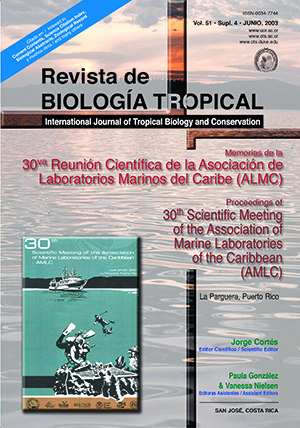Resumen
Durante 1997 y 1998 dos colonias, HL (alta luz) y LL (baja luz) de Millepora alcicornis experimentaron blanqueamiento. Durante 10 días en 1997, la temperatura del agua sobrepasó 1.5°C el promedio de 1992-1997. Se observó que HL sufrió blanqueamiento, mientras que LL mantuvo su color. Al cabo de varias sema-nas, la colonia HL recuperó completamente su pigmentación natural (blanqueamiento reversi-ble). En 1998 la temperatura sobrepasó 3°C el valor promedio durante 10 días. HL y LL su-frieron blanqueamiento y ninguna logró recu-perarse (blanqueamiento irreversible) y los dos fueron recolonizadas rápidamente por algas e hidroides y todavía (junio 2003) no hay seña-les de recuperación. La eficiencia fotoquímica (ΔF/Fm´) de ambas colonias sufrieron caídas significativas al exponerlas a radiación ultra-violeta pero se recuperaron completamente su-giriendo que la luz ultravioleta no provocó daño permanente. Medidas in situ antes del evento de blanqueamiento del 1998, indicaron que ambas colonias estaban en óptimas con-diciones con respecto a la fisiología. Durante y después del evento de blanqueamiento, ambas colonias mostraron una reducción en la efi-ciencia fotoquímica. Estos resultados indican que la temperatura no es el único factor que causa blanqueamiento y que la radiación solar debe también jugar un papel importante en el blanqueamiento de coral.Citas
Glynn, P. W. 1996. Coral reef bleaching: facts, hypotheses and implications. Global Change Biol. 2: 495-509.
Gorbunov, M.Y., Z.S. Kolber, M.P. Lesser & P.G. Falkowski. 2001. Photosynthesis and photoprotection in symbiotic corals. Limnol. Oceanogr. 46: 75-85.
Iglesias-Prieto, R., J.L. Matta, W.A. Robins & R.K. Trench. 1992. Photosynthetic response to elevated temperature in the symbiotic dinoflagellate Symbio-dinium microadriaticum in culture. Proc. Natl. Acad. Sci. USA 89: 10302-10305.
Jeffrey, S.W. & G.F. Humphrey. 1975. New spectrophoto-metric equations for determining chlorophylls a, b, c1 and c2 in higher plants, algae and natural phyto-plankton Biochem. Physiol. Pflanzen 167: 191-194.
Jones, R.J., O. Hoegh-Guldberg, A.W.D. Larkum & U. Schreiber. 1998. Temperature-induced bleaching of corals begins with impairment of the CO2 fixation mechanism in zooxanthellae. Plant Cell Environ. 21: 1219-1230.
Kolber, Z., J. Zehr & P. Falkowski. 1988. Effects of growth irradiance and nitrogen limitation on photo-synthetic energy conversion in Photosystem II. Plant Physiol. 88: 923-929.
Lesser, M. P. 1996. Exposure of symbiotic dinoflagellates to elevated temperatures and ultraviolet radiation causes oxidative stress and inhibits photosynthesis. Limnol. Oceanogr. 41: 271-283.
Maxwell, D.P., S. Falk & P.A. Huner. 1995. Photosystem II excitation pressure and development of resistance to photoinhibition. I. Light-harvesting complex II abundance and zeaxanthin content in Chlorella vulgaris. Plant Physiol. 105: 535-543.
Warner, M.E., W.K. Fitt & G.W. Schmidt. 1996. The effect of elevated temperature on the photosynthetic efficiency of zooxanthellae in hospite from four dif-ferent species of reef coral: A novel approach. Plant Cell Environ. 19: 291-299.
Warner, M.E., W.K. Fitt & G.W. Schmidt. 1999. Damage to photosystem II in symbiotic dinoflagellates: A de-terminant of coral bleaching. Proc. Natl. Acad. Sci. USA 96: 8007-8012.
##plugins.facebook.comentarios##

Esta obra está bajo una licencia internacional Creative Commons Atribución 4.0.
Derechos de autor 2003 Revista de Biología Tropical


